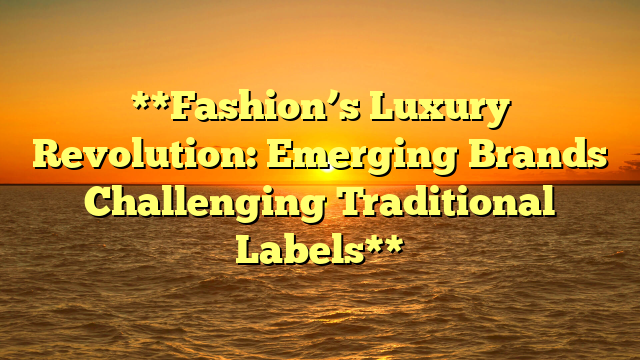
The luxury fashion industry, long dominated by iconic houses like Chanel, Gucci, and Louis Vuitton, is undergoing a seismic shift. A new wave of emerging brands is challenging the status quo, redefining what luxury means in the 21st century. These innovative labels are not only disrupting traditional business models but also reshaping consumer expectations, sustainability practices, and the very essence of exclusivity. This revolution is driven by a combination of creativity, technology, and a deep understanding of modern values, making it one of the most exciting developments in fashion today.
One of the most significant ways emerging brands are challenging traditional labels is through their emphasis on sustainability. Established luxury brands have often been criticized for their environmental impact, from excessive waste to unethical sourcing practices. In contrast, brands like Stella McCartney, Marine Serre, and Gabriela Hearst are leading the charge in sustainable luxury. They prioritize eco-friendly materials, transparent supply chains, and circular fashion principles. For instance, Marine Serre’s upcycled collections and Gabriela Hearst’s carbon-neutral runway shows are setting new standards for the industry. samosir88 prove that luxury and sustainability are not mutually exclusive, appealing to a growing segment of environmentally conscious consumers.
Another key factor driving this revolution is the democratization of fashion through technology. Social media platforms like Instagram and TikTok have leveled the playing field, allowing emerging brands to reach global audiences without the need for massive marketing budgets. Labels such as Telfar, Jacquemus, and Amina Muaddi have leveraged these platforms to build cult-like followings. Telfar, for example, gained immense popularity through its iconic Shopping Bag, which became a symbol of inclusivity and accessibility in luxury fashion. By embracing direct-to-consumer models and engaging directly with their audiences, these brands are bypassing traditional gatekeepers and creating a more personal connection with their customers.
Inclusivity is another area where emerging brands are outpacing traditional labels. While many established luxury houses have been slow to embrace diversity, newer brands are making it a cornerstone of their identity. Rihanna’s Fenty label, for instance, has been celebrated for its inclusive sizing and diverse representation in advertising campaigns. Similarly, Telfar’s “Not for You—For Everyone” slogan encapsulates its commitment to breaking down barriers in luxury fashion. These brands are not only catering to a broader audience but also challenging the elitist connotations often associated with luxury.
The rise of emerging brands is also reshaping the concept of exclusivity. Traditional luxury labels have long relied on scarcity and high price points to maintain their allure. However, younger consumers are increasingly valuing authenticity, storytelling, and innovation over mere exclusivity. Brands like Off-White, founded by the late Virgil Abloh, have mastered the art of blending streetwear with high fashion, creating a new kind of luxury that resonates with millennials and Gen Z. By collaborating with artists, musicians, and even other brands, these labels are creating unique experiences that go beyond the product itself.
While traditional luxury brands still hold significant influence, the rise of emerging labels signals a broader shift in the industry. Consumers are no longer content with outdated notions of luxury; they want brands that align with their values, embrace innovation, and offer something truly unique. As these challenger brands continue to gain traction, they are forcing established players to adapt or risk becoming irrelevant. The luxury fashion revolution is here, and it’s being led by a new generation of designers and entrepreneurs who are redefining what it means to be luxurious in the modern era.




